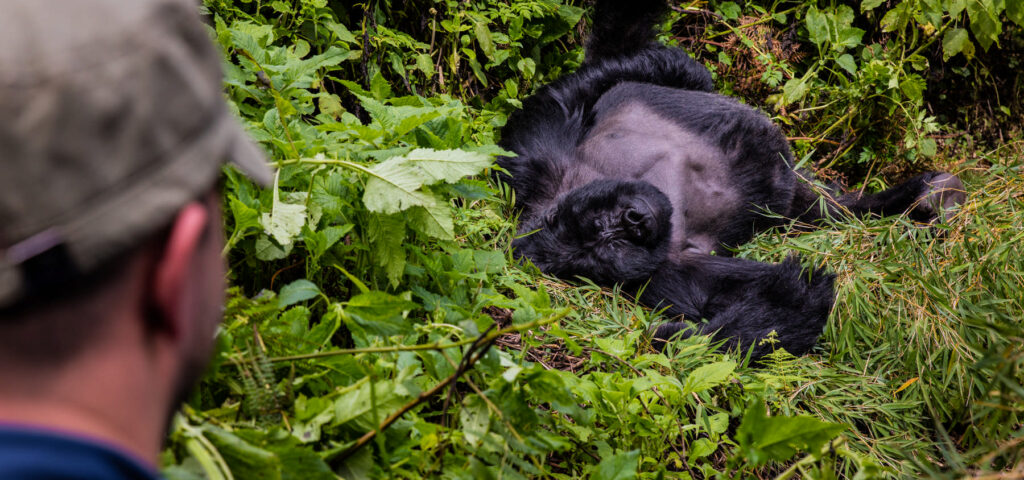Planning your dream safari to Uganda or East Africa?
You’ve probably asked yourself:
“How much does a safari really cost — and what am I paying for?”
Safaris aren’t one-price-fits-all trips — they include park permits, lodges, meals, guides, transport, and logistics across vast distances. This guide breaks it all down so you know what’s included, why prices vary, and how to plan smartly for your next adventure.
1. Who Is Included in the Price?

Safari pricing starts with who the trip is for — and who you’re supporting.
Who’s paying
Your group size and travel style matter. A solo or private safari costs more per person than traveling with friends or family in a small private group.
What’s included
A Nandi Adventures safari typically covers:
- Professional local guide and driver
- Park and trek permits (gorillas, chimps, etc.)
- In-country transport (4×4 vehicle or charter flight if needed)
- Accommodation (lodge, tented camp, or boutique stay)
- Meals during the safari
- Activities and experiences listed in your itinerary
Who you’re supporting
Behind every safari is a community — guides, park staff, families, and conservation teams.
When you book with Nandi Adventures, your journey supports the people and places that make your safari possible.
2. What You’re Paying For
Here’s what influences safari costs in Uganda, Rwanda, Kenya, and Tanzania:
| Item | What It Covers |
|---|---|
| Accommodation | From basic lodges to luxury tented camps — more comfort means higher cost. |
| Duration | Each extra night adds lodging, meals, transport, and guide time. |
| Permits & Park Fees | Gorilla and chimpanzee trekking or park entry are major cost drivers. |
| Transport | Distance, road conditions, and need for internal flights affect pricing. |
| Meals & Water | Usually full board — breakfast, lunch, and dinner. |
| Activities | Game drives, boat safaris, guided walks, or cultural visits. |
| Season & Demand | Peak months mean higher rates due to limited space and permits. |
| Sustainability & Ethics | We partner only with lodges that pay fair wages, support communities, and protect habitats — adding real value (and cost). |
Gorilla Trekking Tip:
A gorilla permit in Uganda costs USD 800 per person and in Rwanda USD 1,500 per person.
This fee directly funds mountain gorilla conservation and supports nearby communities.
In short:
Your safari price covers your stay, your journey, the wildlife, and the positive impact you leave behind.
3. When You Travel Affects the Cost
High Season (June–September, December–February)
Best weather, great wildlife viewing, and premium lodge rates.

Shoulder Season (March–May, October–November)
Fewer tourists, greener landscapes, and better value.
Book early
Gorilla and chimp permits are limited and sell out months ahead. Booking early ensures availability and better lodge options. If you’re flexible with dates, comfort level, or park choice, you can enjoy a world-class safari for less.
4. Where You Go Makes a Difference
National parks in Uganda and the East Africa region vary in location, access, and experience — and that shapes your safari cost.
- Parks closer to main routes generally cost less.
- Remote parks or those requiring internal flights cost more.
- Gorilla trekking in Bwindi Impenetrable National Park is pricier due to permits and logistics.
💡 Tip: Consult a trusted local expert to design a safari that fits your travel goals — without hidden surprises.
5. Why Safari Prices Are What They Are
Safaris are complex, multi-layered experiences involving people, logistics, and conservation.
- Logistics: Guides, vehicles, fuel, flights, and accommodation all add up.
- Fixed costs: Park fees and wildlife permits are set by national authorities and non-negotiable.
- Scale: Many lodges are small and remote, so per-guest costs are higher.
- Value & impact: Your payment supports wildlife protection and local livelihoods — part of the Nandi Adventures promise.
You’re not just paying to see wildlife — you’re investing in nature, people, and purpose.
When reviewing quotes, ask:
How many nights? What kind of accommodation? Which permits? Which parks? When is the travel date?
These determine your safari’s true value. Your quote isn’t just a number — it’s the story of your journey.
Traveler Tips for the Best Value
- Prioritize what matters most — gorilla trekking, wildlife, great migration, beach, or luxury.
- Travel in the shoulder season for lower prices.
- Share costs by traveling with friends or family.
- Travel light especially if you expect to take domestic flights. Baggage allowance is 15kg
- Choose a trusted local operator who reinvests in communities and conservation.
A safari price isn’t only about wildlife — it’s about the people, the places, and the impact your journey creates.
Typical Uganda Safari Price Ranges (Per Person based on 2 sharing)
| Safari Type | Price Range (USD) | Style |
|---|---|---|
| Budget Safari | $300–$450/day | Basic lodges, camping, homestays (where available) |
| Mid-Range Safari | $400–$1000/day | Comfortable lodges, private guide |
| Luxury Safari | $800–$2,500+/day | Exclusive camps, flights between parks |
(Indicative costs include full board, park fees, road transfers, and guide services — based on two travelers. Costs may vary for regional countries)
Additional costs to consider
- Gorilla trekking permits: USD 800 per person per permit, USD 1500 per habituation permit
- Chimpanzee trekking permits: Approximately USD 250 per person
- Internal/Domestic flights between parks and destinations may range from USD 200 per route per person to well over USD 1,000. Type of aircraft matters with charter and helicopter costing more.
- Visa: Approximately USD 50 per person (for a single entry) for Uganda visa.
- Medical Requirements: Required vaccinations (yellow fever), and insurance on country by country basis in East Africa. Zanzibar requires mandatory local insurance when visiting
- Tips: Varies, but expect around USD 10– USD 20 per day for guides and staff
- Souvenirs and gifts: open budget
How to Plan a Safari That Fits Your Budget
- Be clear about your priorities: wildlife, comfort, or culture.
- Book early for gorilla permits and best lodge rates.
- Travel as a small private group to share costs.
- Support local operators who invest back into communities.
Understanding safari pricing helps you plan wisely and travel meaningfully. Behind every dollar is a network of guides, rangers, communities, and conservation programs that make your adventure possible.
Safari Pricing FAQs
Q: Why are gorilla trekking safaris expensive?
Because the permit funds conservation and community projects protecting the last remaining mountain gorillas. In Uganda a percentage of every permit and park entry fees supports schools, clinics, and local livelihoods in the immediate communities.
Q: Are flights between parks worth it?
Yes — they save long drives and add comfort, especially for older travelers or those on luxury safaris.
Q: How can I reduce my safari cost?
Travel in the shoulder season, share a private trip with friends or family, or choose mid-range lodges.
Q: What’s included in a Uganda safari price?
Accommodation, meals, park fees, transport, guide services, and core activities such as game drives, permits, or boat safaris.



